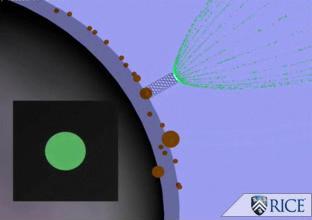A new video shows the growth of carbon nanotubes, atom by atom, and reveals that they rotate as they grow.

A study conducted by researchers from the University of Lyon in France and Reese University in Houston, Texas, and published online in the scientific journal Nano Letters this month, provides the first ever experimental evidence of the process by which individual carbon atoms are added one by one to growing nanotubes.
"The main feature in exploiting the ability of carbon nanotubes has always been a better control of their growth," says research team leader Stephen Purcell from the University of Lyon. "Our findings provide new insights into improved measurement, imaging and control of nanotube growth."
Carbon nanotubes are elongated hollow cylinders of pure carbon. In their shape they are similar to a human hair, but they are a hundred thousand times smaller. In addition, they are also six times stronger than steel, conduct electricity like copper and are almost completely resistant to radiation or chemical damage. As a result of these properties, scientists are eager to use them in extremely powerful "smart" materials, but they must better understand how to make them.
"The video images of the study show the self-assembly of atom after atom to obtain the nanotube," explains one of the research partners. "The film presents compelling evidence for the rotational motion accompanying nanotube growth. The phenomenon reminds us of Galileo's well-known quote: "Nevertheless, move will move."
In February of this year, researcher Yakobson presented a new theory that proposed that the nanotubes grow like tiny woven fabrics, with the new atoms connecting into twisted atomic strands. The new video appears to bolster this theory, suggesting that the atoms are added in pairs as the tube rotates and grows.
To obtain the images, the research team used a field emission microscope (FEM). A few atoms of a metal catalyst were placed on the tip of the needle-like microscope detector, and then nanotubes grew over the metal catalyst. An electric current was passed along the detector and the nanotube, then it was emitted as bright images, from top to bottom, of the nanotube on a radiant monitor. The bright spots were captured using a video camera that detected the rotation of the nanotube during its growth.
In one case, a nanotube rotated about one hundred and eighty times during its eleven-minute growth. A picture-by-picture examination of the video film revealed that the rotation proceeds in discrete steps - very similar to the second hand of a mechanical watch - where each full rotation consists of twenty-four steps.
"The results support our predictions regarding the growth mode of the nanotubes," explained the researcher.
